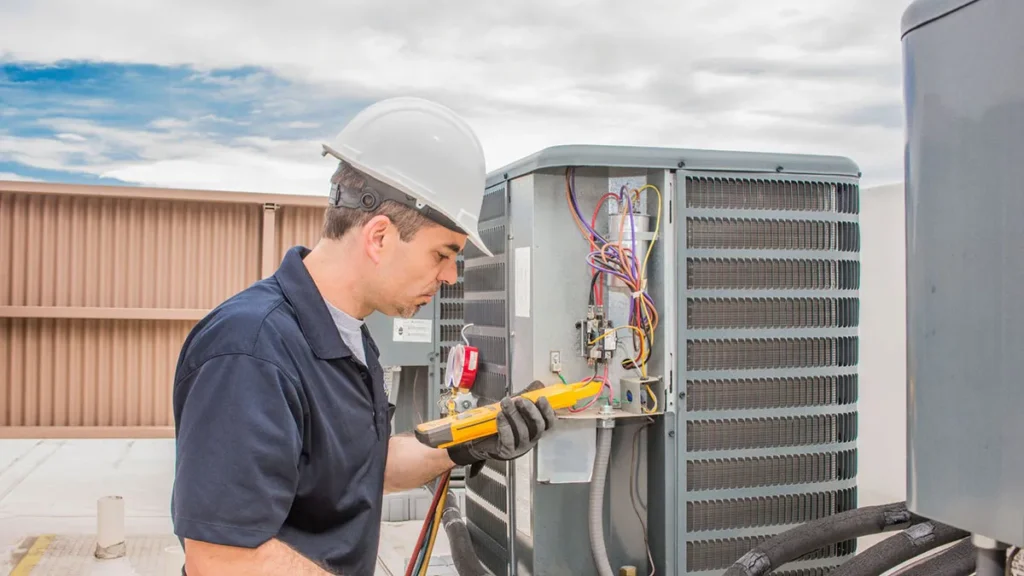There’s nothing quite like the unrelenting Hawaiian heat to make you appreciate a well-functioning air conditioner. But when that cool oasis suddenly dries up, and you’re left sweating it out, one likely suspect could be a blown fuse. These small cylindrical powerhouses play security guard for your AC’s electrical circuits, shutting everything down at the first sign of trouble.
This blog post is your guide to sniffing out if one of those pesky blown fuses is behind your cooling crisis. We’ll cover all the red flags that scream “fuse issue!” – from strange humming noises to circuits that just won’t kick on. You’ll learn the DIY steps to safely identify and replace a blown AC fuse yourself. But we’ll also share when it’s time to wave the white flag and call in the professionals before you create bigger problems.
Tired of feeling like a melted popsicle in your own home? Grab a cold drink, and let’s troubleshoot this AC fuse situation together. With some simple know-how, you could be basking in icy chilled air again in no time!

Understanding AC Fuses
When your air conditioner suddenly loses its cool, one of the first potential culprits to investigate is the fuse. These small cylindrical components may seem insignificant, but they play a mighty important role in keeping your cooling system running safely and efficiently.
Air conditioners rely on a consistent flow of electricity to power the various hardworking parts – compressors, motors, fans, control boards, and more. However, if too much electrical current tries to surge through a circuit, it can lead to overheating wires and fried components, or even spark an electrical fire hazard. This excessive electrical load is where fuses enter the picture.
Fuses act as the guardians of your AC’s electrical circuits. When exposed to a dangerous overload, fuses are designed to “blow” or burn out internally. This blows the fuse and cuts off power to that circuit before any real damage can occur to your expensive equipment. While having to replace a blown fuse disrupts your cooling, it’s a small inconvenience compared to dealing with a catastrophic AC breakdown.
There are different fuse types matched to their amperage rating and circuit application. The lower amperage control circuits utilize affordable cartridge fuses containing a thin metal strip that melts during overloads. For heavy-duty circuits like those powering compressors, larger plug fuses with reinforced ribbon elements provide reliable protection against surges.
So while they may not garner much attention, AC fuses are truly hardworking guardians. These essential components sacrifice themselves to prevent hazards like electrical fires, short circuits, or complete system burnout from an electrical surge incident. Properly maintaining your fuses is an easy way to protect your cooling investment year after year.
Why Does My AC System Keep Blowing Fuses?
While an occasional blown fuse is no cause for panic, if your air conditioning system keeps popping fuses like a malfunctioning jackhammer, you’ve got a more serious issue demanding attention. Frequent fuse blowouts represent your AC’s desperate cry for help against an underlying problem straining its electrical capacity. Ignoring that distress signal risks compounding damage that could leave you sweltering.
One of the most common culprits behind recurrent blown fuses is an overloaded circuit. Air conditioners require a carefully balanced electrical load based on their specifications. Overloads occur when you start demanding more amperage than that circuit can consistently handle – often from running too many high-draw appliances simultaneously or attempting to power an undersized AC above its capabilities. Those excessive current surges repeatedly blow the protective fuse.
Electrical shorts present another likely source of strain behind frequent fuse blowouts. These partial ground faults allowing currents to travel along unintended paths create resistance in the form of heat buildup. As those hot spots intensify from an ongoing short, they’ll eventually grow enough to continuously overload your fuse’s amperage threshold. Worn insulation from aged wiring looms as a prime short circuit culprit.
Problems within your AC system itself can similarly trigger a fuse whack-a-mole situation. A failing compressor drawing excessive amps during startup provides one possibility. Another could stem from blower motors encountering increased resistance from stuck fan blades or collapsed ductwork placing more strain on the electrical supply. Even small control board faults can sometimes cause repeated electrical spikes that blow fuses.
Occasionally the underlying issue boils down to oversized fuses installed previously. While well-intentioned to avoid nuisance blown fuses, using oversized fuse ratings defeats overcurrent protection altogether. Those overly beefy fuses simply allow unsafe load levels to persist until finally burning out catastrophically.
The bottom line – frequently replacing AC fuses acts as a mere Band-Aid masking a larger underlying fire. Whether stemming from an overloaded circuit, electrical fault, mechanical issue, or improper fuse usage, that repetitive blowing signals a serious condition requiring professional diagnosis and repair. Procrastinating just leads to further component damage and potential safety risks from electrical hazards.
Signs of a Blown HVAC Fuse
When your air conditioner’s electrical guardians blow themselves out under strain, they’ll definitely let you know – if you know the right signals to watch for. Being able to promptly identify AC fuse blowouts can often mean the difference between a quick fix and a compounding cooling calamity. Let’s review the common red flags alerting you to fuse issues.
No Cooling Power
The most obvious indication you’re dealing with a blown air conditioner fuse is a complete lack of cooling power – the silence of an unresponsive system leaving you dripping in humid misery.
Warm Air from Vents
One telltale sign lives within your AC’s indoor air handler cabinet. If you notice the blower fan still running but feel only room-temperature air circulating, that’s a strong cue a fuse has blown disrupting the cooling cycle.
No Blower Operation
Conversely, a blower fan that outright refuses to kick on could also signal a blown fuse on the indoor unit’s control circuit. No fan essentially equates to no condenser activity either in these situations.
Silent Compressor
For outdoor condenser units, listening proves the unlocking diagnostic tool. If the compressor sits stubbornly silent when calling for cool air despite the indoor fan running, a blown fuse is quite likely cutting off power to that crucial hardworking component.
Electrical Burning Smell
Strange burning odors could represent another potential warning whiff of blown fuses. As fuse links burn out under excessive load conditions, they may release a signature hot melting plastic or electrical burning smell into circulating air systems.
Visible Damage to Fuse
Of course, visible arcing or charring directly on fuse components provides the most definitive evidence of blowouts. Melted or broken fuse links signify you’ve indeed got a spent sacrificial guardian in need of prompt replacement.
While cooling shutdowns provide the most unmistakable blown fuse indicator, staying alert to these other subtle clues enables you to catch fuse flameouts before they inevitably escalate into larger system faults or hazards. A little preventative detective work pays dividends in maintaining your air conditioner’s longevity.
How to Check an Air Conditioner for a Blown Fuse
When your cooling system sputters and those blown fuse signals start surfacing, it’s time to do some investigating before compounding issues arise. While electrical work requires professional expertise, many homeowners can safely check for fuse blowouts themselves through this process:
Locate Fuse Boxes
First, locate your AC’s fuse boxes – indoor units typically have them in the air handler cabinet while outdoor condenser units house their own fuse panels as well. Consult your owner’s manual for a wiring diagram pointing you to the fuse locations if not immediately visible.
Inspect for Visible Damage
With all power sources disabled, open the fuse panels and visually inspect each installed fuse closely using a flashlight. Look for any melted end caps, breaks along fuse bodies, or charring around sockets – clear signs of a spent sacrificial guardian.
Check Continuity
If fuses appear undamaged, you’ll need to test continuity with a multimeter. Set it to read resistance (Ohms), then touch probes to each fuse’s metal end caps while leaving them seated. Readings approaching zero Ohms mean that the fuse remains operational. Any infinite Ohm measurement indicates an internally blown fuse with an open circuit even if the exterior looks fine.
Don’t rely just on visual inspections though. Thermal safety fuses can fail in non-evident ways, so it’s wise to test continuity on all suspect fuses definitively.
By systematically checking fuse conditions, you can quickly identify any flameouts in need of replacement. This also provides clues to the root overload issues straining your system so those underlying problems can be resolved properly. A little diagnostic diligence goes a long way toward keeping your cool all summer!
Replacing a Blown AC Fuse
Once you’ve pinpointed the blown fuse culprit behind your AC’s outage, it’s time to get that electrical PRP (personal risk professional) swapped out with a fresh recruit. While fuse replacements rank fairly basic among HVAC tasks, they still require precautions to protect your safety – and sanity too when dealing with summer scorchers.
First, locate the accurate replacement fuse matching your system’s circuit requirements for voltage, amperage, and fuse type. Sizing specifications get printed directly on fuse bodies and sockets as a handy reference. Resist any temptation to randomly upsize for a “stronger” fuse – using overcapacity ones defeats their entire safety purpose by allowing unsafe current overloads.
With your properly specified fuse replacement in hand, shut off all power sources feeding your AC unit including the system disconnect box and main circuit breaker. Give capacitor banks a solid five minutes to discharge residual energy before proceeding. Once de-energized, you can safely access fuse panels and remove that faulty unit with a well-insulated fuse puller tool.
Insert your new fuse into the vacant socket carefully, securing end caps fully to maintain proper circuit contacts. Avoid excessive force to prevent damaging fuse housings or sockets themselves. If swapping out a non-cartridge style fuse holder, ensure those connections are tight when reinstalling.
With the fresh fuse situated, you can restore power sources systematically and fire your AC system back up for testing. Keep a watchful eye – if that new puppy blows itself out again rapidly, it’s a surefire indicator of a larger underlying overload issue demanding professional diagnosis.
Don’t fear the fuse swap! Applying some basic safety protocols and using the properly specified parts provides most homeowners with a straightforward resolution for knocking out electrical faults and reviving their cooling relief once more.
When to Call a Professional
While fuse replacements fall within the DIY realm for handy homeowners, some electrical troubleshooting eventually requires professional reinforcements. Knowing the limitations of your fuse fiddling keeps both you and your cooling investment safe.
If replacements keep blowing soon after installation, that’s a neon sign urging you to holster the voltage meters and call an expert. Chronic fuse failures indicate a deeper overload condition compromising your system’s entire electrical supply – an issue too complex for DIY sleuthing alone.
Similarly, fuses blowing along with tripped circuit breakers demand professional eyes scrutinizing both components together. Those cascading failsafes signify extreme amperage spikes overloading protection barriers simultaneously – a frightening scenario needing immediate expert triage.
If you uncover burnt wiring, heat damage, or component discoloration, stop and power down everything. Electrical fire evidence takes diagnosing out of the amateur realm until proven safe by licensed technicians.
Air Conditioning Problems? Leave It to the HVAC Professionals at Steve’s Plumbing
Don’t sweat it out wrestling with blown AC fuses – leave that headache to Hawaii’s trusted HVAC experts at Steve’s Plumbing & A/C Service. For over 35 years, their certified technicians have swiftly diagnosed and repaired every cooling catastrophe using premium testing equipment and methods.
Steve’s gets to the root of overload causes, not just slapping band-aid fuse replacements. You’ll receive transparent explanations of all findings and upfront pricing before any repair work proceeds. Beyond fuse troubleshooting, Steve’s comprehensive services provide preventative maintenance to maximize your system’s longevity. Stay cool and call (808) 563-4054 to book our seasoned professionals today!

